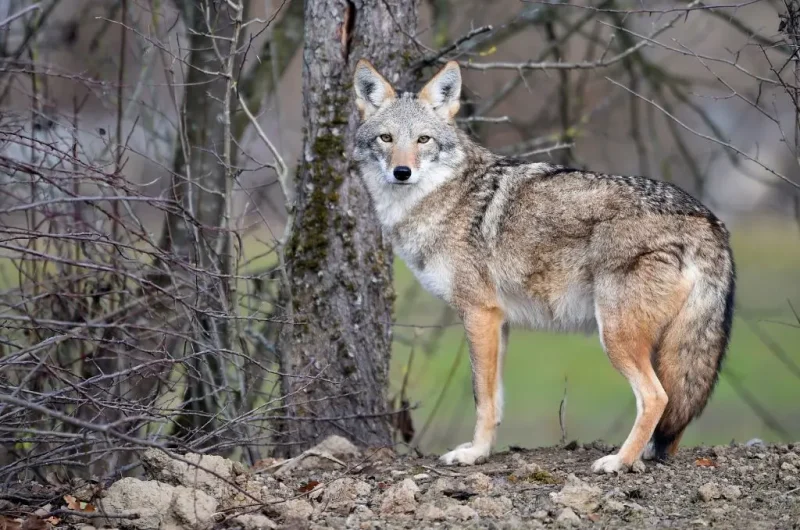
OAN Commentary by: Kenin M. Spivak
Tuesday, October 7, 2025
Coyotes are invading urban America. I don’t mean guides for illegal immigrants. I mean the four-legged cousin to wolves and dogs. But, as with two-legged predators, progressives blame the victims and protect the aggressors.
The U.S. coyote population is steadily increasing and expanding, particularly in suburbs and cities. All states except Hawaii report coyotes, with the largest concentrations in Texas (860,000), California (250,000 to 750,000, an obscure range), Arizona (200,000), Kansas (150,000 to 200,000) and New Mexico (125,000). Cities with growing coyote populations include Chicago, Los Angeles, San Francisco, Seattle, New York, Atlanta, Denver, Phoenix, Portland, Minneapolis, Salt Lake City, and San Antonio.
Coyotes spend their days hunting small animals, or, when they hunt in packs, also deer and livestock. Though they tend to be afraid of people and loud noises, urbanized coyotes, and coyotes with rabies, or whose den or pups are threatened, can lose that fear.
They are smart, adaptable, independent, dangerous killers. Few dogs would win a fight with a coyote, and almost none with a pack.
There are no accurate studies on coyote attacks, though anecdotal evidence, including online videos, suggests attacks on small pets and menacing of humans, particularly toddlers, are frequent, and increasing. A study prior to the explosion in the urban coyote population found at least 165 attacks on humans in California from 1977 through 2015. The Coyote Catcher app includes reports of hundreds of pet attacks in Southern California.
So-called experts and the media are fixated on co-existence. In May, The New York Times wrote about the rapid growth of the coyote population in San Francisco. Though acknowledging that coyotes had attacked children and killed dogs, the Times observed, “Generally speaking, the problem, scientists say, is not the coyotes…. It is the humans.” Specifically, the Times explained that humans have to change their way of life. They must stop permitting their dogs and children to play outside, leaving bait on piers, or filling trash cans.
The Times quoted an assistant professor who insisted the city would be far worse off without coyotes, because they kill rats and cats. Commenting on an aggressive coyote killed by officials, a wildlife ecologist characterized it as a failure of the public to be good stewards of the land and of government to better educate people about living with coyotes.
In August, the Times turned its attention to coyotes living in New York’s Central Park. The author was elegiac in her depiction of a coyote pair named Romeo and Juliet. The noble couple spend their days hunting. They are “extremely shy,” and can swim faster than rats. Spotting them is “serendipity” coveted by their fans.
According to the Times, a few years ago, the police chased another coyote. He died because of “stress, heartworms and rodenticide.”
The Times advises us that “coyote experts insist that people should not fear them,” and seeing coyotes is no reason to call the police, though, revealingly, we should “appreciate” them “from a distance.” By the way, keep your dog on a leash, because being pursued by a dog is “stressful” for coyotes.
Residents in my liberal Los Angeles neighborhood now carry sticks, knives, BB guns, rocks and noisemakers. Walks have become exercises in vigilance and tension, rather than relaxation and joy. Head on a swivel.
Caution, retreat, security, changing our behavior, and accepting risk is the prescription from so-called experts and officials who implicitly reject the premise that urban Americans deserve the peace and tranquility of a relaxed life free from killers.
Relocating coyotes often doesn’t work. Between their awe-inspiring sensitivity to the earth’s vibration, sextant-like brains, and olfactory capabilities, many return to their territories.
Paradoxically, hunting can increase coyote populations. In the wild, it reduces their average age, increasing litters. There is evidence that when the pack leaders are killed, remaining members are more likely to mate. Finally, their odor attracts coyotes from other territories.
Exterminating entire packs, or all residents of a den, followed by cleaning out dens would mitigate the shortcomings of a random hunt. This requires Democrat elected officials to act against the aggressors, rather than demand accommodations from the victims. Sound familiar?
The rights of rodents, poisonous snakes and coyotes do not outweigh the physical and emotional well-being of people and their pets. Explaining to officials who favor restorative justice for murderers, or are fearful of progressive blowback, that co-existence with animal predators is not a tolerable strategy is a Kafkaesque dialogue. Nonetheless, if change is not immediate, life in many cities will soon be very much worse.
(Views expressed by guest commentators may not reflect the views of OAN or its affiliates.)
Kenin M. Spivak is founder and chairman of SMI Group LLC, an international consulting firm and investment bank. He is the author of fiction and non-fiction books and has served as a director and C-suite officer of public and private companies.
What do YOU think? Click here to jump to the comments!
Sponsored Content Below

